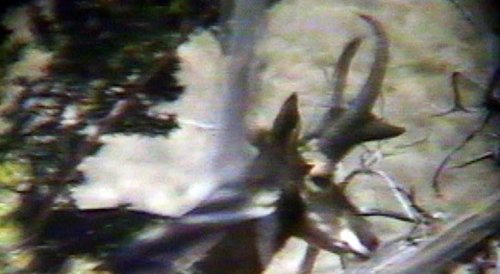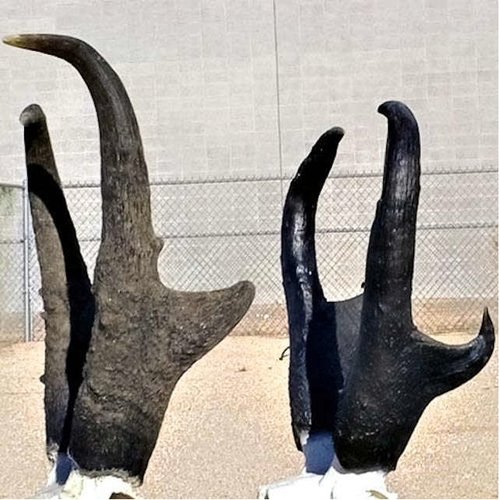I was aware that pronghorn bucks matured at a young age, but this is even more enlightening. So much for having to find an old buck to make be a big buck.
Might explain why a heavy harvest in some WY units still allows some bucks to reach B&C entry scores.
Might explain why a heavy harvest in some WY units still allows some bucks to reach B&C entry scores.
TROPHY POINTS: Big Game Research Online -- Part 7
Re-posted from www.boone-crockett.org
Monday, January 24, 2011
Pronghorn Evolution and Management
By David Hewitt - Boone and Crockett Club Professional Member
It is an axiom that management for trophy deer, sheep, and goats requires management for older males because antler and horn size increase with age. For example, antlers continue to increase in size each year until white-tailed deer bucks reach at least 5 years of age, bull elk 7 years of age, and bull moose 10 years of age. For this reason, wildlife management programs that seek to produce trophy animals emphasize a low harvest rate of males, or a selective harvest that enables males with the most potential for large horns/antlers to mature.
Pronghorn are an exception to this pattern. In fact, pronghorn are exceptional in many ways. Pronghorn are the only species with a horn (keratinous head ornamentation) that has a prong and is shed annually. Pronghorn are found only in North America, whereas deer, sheep, and goat species are found throughout much of the world. Pronghorn are the only member of their family (Antilocapridae); compared to the 50 species of deer and 35 species of sheep and goats, pronghorn are indeed a North American original.
Another unique aspect of pronghorns compared to other game animals is that their horns reach a maximum size at a relatively early age. Studies of pronghorn from Colorado north to Montana and Alberta consistently show pronghorn achieving a plateau in horn size by 2 – 3 years of age. Pronghorn in New Mexico and Arizona may have peak horn size later, perhaps 4-5 years of age. Furthermore, young bucks (less than four years of age) are often half of the top 10 largest pronghorn harvested in a region. The highest scoring Boone and Crockett pronghorn trophies, in which the animals’ ages are known, are three years old or younger!
Why do pronghorn have this unique pattern in horn growth? One explanation suggests the horn growth pattern is part of a suite of traits that have enabled pronghorn to thrive in variable environments. Southern pronghorn range has periodic drought and northern ranges have periodic blizzards that can, and do, occasionally kill large numbers of animals. Any pronghorn that mature slowly risk not breeding at all before a particularly bad drought or winter killed them. Conversely, pronghorn that matured quickly and bred at an early age had a better opportunity of leaving offspring.
Thus, the pronghorn we see today have been shaped through evolution to mature and breed at an early age. Pronghorn reach adult body size by 1.5 to 2 years of age. Females usually breed as yearlings; males are capable of breeding as yearlings but may not have many opportunities if older, more dominant males are around. And the horns of males reach maximum size at an early age.
Because the horn sheaths are grown anew each year, factors like precipitation and forage quality appear to affect annual sheath growth rates. The roles of maternal condition during gestation, population density, and genetics in modulating horn growth potential need further study.
Management consequences of large horns being possible on young pronghorn:
* An exceedingly low harvest of male pronghorn is not necessary for production of trophy pronghorn.
* Instead, pronghorn managers may allow moderate harvest of bucks, and given good range conditions, reasonably expect most pronghorn to achieve their potential in horn growth.
* More people can be given an opportunity to hunt pronghorn, and possible harvest a trophy, than would be possible if pronghorn horns continued to increase in size until males were much older.
Thanks to Carl Mitchell and David Brown for sharing ideas and literature on pronghorn horn growth.
For more information on pronghorn growth patterns see:
C. D. Mitchell and C. R. Maher. 2001. Are Horn Characteristics Related to Age in Male Pronghorns? Wildlife Society Bulletin 29:908–916.
C. D. Mitchell and C. R. Maher. 2006. Horn Growth in Male Pronghorns (Antilocapra americana): Selection for Precocial Maturation in Stochastic Environments. Acta Theriologica 51:405–409.
K. Morton, P. F. Jones, and M. Grue. 2008. Comparison between Pronghorn Age and Horn Size in Southern Alberta. Proceedings Pronghorn Workshop 23:104–114.
D. E. Brown, W. C. Keebler, C. D. Mitchell. 2010. Hunting and trophy horn size in male pronghorn. Proceedings Pronghorn Workshop 24:In press.
Trophy Points: Big Game Research On Line is complied and edited by David G. Hewitt, a Professional Member of the Boone and Crockett Club and the Stuart W. Stedman Chair for White-tailed Deer Research at the Caesar Kleberg Wildlife Research Institute.






